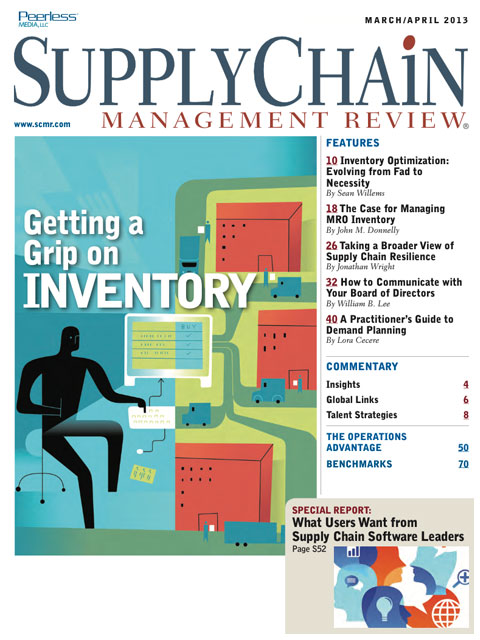Sorry, but your login has failed. Please recheck your login information and resubmit. If your subscription has expired, renew here.
March-April 2013
Inventory needs to be “optimized” to properly match supply and demand. This has become all the more important as competition intensifies globally and supply chains get longer and longer. Learn from a subject matter expert about the benefits of inventory optimization and how to get an IO initiative on track in your organization Browse this issue archive.Need Help? Contact customer service 847-559-7581 More options
Within most organizations, the words “demand planning” cause a reaction—and typically not a mild one. It is characterized by emotional extremes like anger, despair, disillusionment, or even hopelessness. Seldom do we find a team excited or optimistic about their chances to improve demand planning processes.
After two decades of process and technology refinement, excellence in demand management still eludes supply chain teams. In fact, it is the supply chain planning application with the greatest gap between performance and satisfaction. At the same time, it’s the application with the greatest planned future spending. For most teams, demand planning is a conundrum, a true love-hate relationship. They want to improve the demand planning process, but remain skeptical that they can ever do so.
In our research at Supply Chain Insights, we find that demand planning is the most misunderstood—and most frustrating—of any supply chain planning application. While companies are the most satisfied with warehouse and transportation management, they are the least satisfied with demand planning.
 |
This complete article is available to subscribers
only. Click on Log In Now at the top of this article for full access. Or, Start your PLUS+ subscription for instant access. |
Not ready to subscribe, but need this article?
Buy the complete article now. Only $20.00. Instant PDF Download.
Access the complete issue of Supply Chain Management Review magazine featuring
this article including every word, chart and table exactly as it appeared in the magazine.
SC
MR
Sorry, but your login has failed. Please recheck your login information and resubmit. If your subscription has expired, renew here.
March-April 2013
Inventory needs to be “optimized” to properly match supply and demand. This has become all the more important as competition intensifies globally and supply chains get longer and longer. Learn from a subject… Browse this issue archive. Access your online digital edition. Download a PDF file of the March-April 2013 issue.
 |
Download Article PDF |
Within most organizations, the words “demand planning” cause a reaction—and typically not a mild one. It is characterized by emotional extremes like anger, despair, disillusionment, or even hopelessness. Seldom do we find a team excited or optimistic about their chances to improve demand planning processes.
After two decades of process and technology refinement, excellence in demand management still eludes supply chain teams. In fact, it is the supply chain planning application with the greatest gap between performance and satisfaction. At the same time, it’s the application with the greatest planned future spending. For most teams, demand planning is a conundrum, a true love-hate relationship. They want to improve the demand planning process, but remain skeptical that they can ever do so.
In our research at Supply Chain Insights, we find that demand planning is the most misunderstood—and most frustrating—of any supply chain planning application. While companies are the most satisfied with warehouse and transportation management, they are the least satisfied with demand planning.
 |
SUBSCRIBERS: Click here to download PDF of the full article. |
SC
MR

Latest Supply Chain News
- Retail sales see gains in October, reports Commerce and NRF
- Balancing green and speed: Home delivery insights from the pandemic era
- AdventHealth named top healthcare supply chain by Gartner
- Geopolitical readiness in supply chains: Strategic challenges for leaders
- Unlocking retention: The role employee engagement plays
- More News
Latest Podcast

 Explore
Explore
Latest Supply Chain News
- Retail sales see gains in October, reports Commerce and NRF
- Balancing green and speed: Home delivery insights from the pandemic era
- AdventHealth named top healthcare supply chain by Gartner
- Geopolitical readiness in supply chains: Strategic challenges for leaders
- Unlocking retention: The role employee engagement plays
- Can supply chain managers embrace an entrepreneurial mindset?
- More latest news
Latest Resources

Subscribe

Supply Chain Management Review delivers the best industry content.

Editors’ Picks





